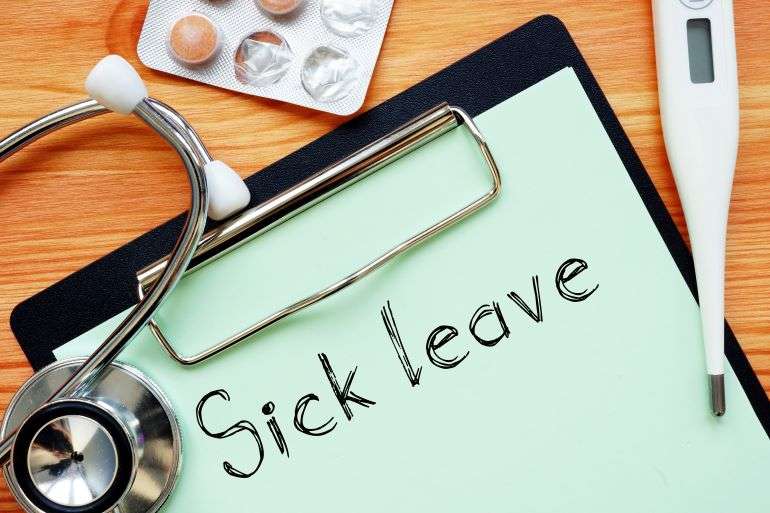First published on Thursday, Jun 04, 2020
Last updated on Monday, Mar 11, 2024
From time-to-time your employees will require sick leave from work. As an employer, you have a responsibility to manage sickness leave correctly.
Navigating sick leave can be a complex process. You may have questions about your employee's rights when it comes to sick leave or what to include in your sick leave policy.
In this article, we'll lay out everything you need to know about sick leave, from legal essentials to practical tips for handling time off when and employee returns to work.
What is sick leave?

According to the Canadian Government website, the definition of sick leave is a form of job-protected leave that protects an employees’ income when they’re unable to work.
Sick leave can be paid or unpaid. And it can be used for several reasons including illness, injury, or medical emergency.
The importance of paid sick leave
Providing your employees with paid sick leave brings numerous advantages, including:
- Economic benefits
- Improvements in public health
- Enhanced job satisfaction and productivity
- A healthier workforce
- Better public health outcomes, such as the containment of infectious diseases
Many employees try to work through illnesses because of job uncertainty. But, if you provide the option for them to stay home and recover, they'll feel comfortable taking a sick day to recover from illness without worrying about losing their financial stability.
While you're not mandated to provide paid sick leave to your employees, employer-paid sick leave can help your employees handle their family care responsibilities.
It provides them with the assurance that they can take the time off they need without jeopardizing their employment or financial stability. This includes the ability to prioritize their own health as well as the well-being of their family members without having to compromise their earnings.
Another type of leave employers should consider is parental leave, as it supports employees in managing family care.
Economic impact
Employee turnover and productivity can be directly influenced by paid sick leave.
Research shows that staff retention, job satisfaction, and profitability are enhanced when your employees have access to paid sick leave.
It’s a simple equation: when employees can take time off to recuperate from illnesses or manage work-family responsibilities, they are more likely to be dependable, satisfied, and productive.
On the other hand, when companies don't offer paid sick leave, they leave themselves open to many problems. Examples of these include:
- Increased expenses
- Elevated turnover rates
- Reduced employee contentment
- Decreased productivity
- More illnesses in the workplace
These all contribute to a drop in your business's financial productivity, and nobody wants that.
Public health
Offering your employees paid sick leave and sickness benefits can also be immensely beneficial to public health.
When unwell employees can stay home without facing financial difficulties, it reduces the chances of them transmitting infectious diseases to their co-workers and clients, especially if they are in customer-facing roles.
You can also lower future health expenses by providing employees with sick leave.
Employees may put off seeking medical care if they don't have paid sick leave, which may result in more serious health problems and increased treatment expenses in the future. So, giving them the time to consult a medical doctor promptly helps prevent such issues.
Plus, having access to paid sick leave also helps with:
- Improved overall health outcomes, such as a reduced risk of mortality
- Economic security and wellbeing of workers dealing with significant health issues
- Fostering a healthier and more secure workforce
Legal aspects of sick leave
The legal aspects of sick leave vary greatly across different provinces and Jurisdictions.
Some jurisdictions provide more days than others, and employees in these provinces can expect to receive sick leave provisions in line with employment standards at the minimum. the
In addition to the provincial minimums, some workers also receive more comprehensive employer-provided sick leave benefits. Employees working for the same employer in different provinces can still expect to receive generous sick leave provisions.
Meanwhile, in some countries, there are no established federal legal obligations for unpaid or paid sick leave. However, private employers have the discretion to offer sick leave benefits as part of their internal policies.
International perspectives
Around the world, over 145 countries have legislated paid sick leave for short- or long-term illnesses. This makes paid leave an essential aspect of employee rights and benefits, contributing to a healthier and more productive workforce.
Among these countries, 127 provide a week or more of paid sick leave annually. However, the duration of paid sick leave varies across different countries.
For example, countries like:
- The Netherlands
- Ireland
- Switzerland
- Sweden
- Denmark
- Finland
Offer around 10 days, while Switzerland provides up to 103 weeks.
Domestic regulations
Looking within Canada, sick leave policies can differ significantly depending on where you operate your business.
There are no federal statutory obligations for paid sick leave. However all provinces have mandated sick pay regulations according to their employment standards.
Here are a few examples of the varying amounts of sick days employees in different provinces are eligible for:
- Employees in federally regulated workplaces have the right to accumulate sick leave with compensation for a maximum of 10 days per year.
- Employees in Saskatchewan are entitled to up to 12 days of unpaid sick days each calendar year.
- Employees in British Columbia are entitled to 5 days of paid sick leave plus an additional 3 days of unpaid leave.
- Employees in Alberta are entitled to casual illness leave of 10 sick days per calendar year.
Employee entitlements and eligibility

In addition to learning what the mandatory provisions for employee sick leave are in your province, it's also important to understand employee entitlements and eligibility. Employees may be eligible for only a certain number of job-protected unpaid sick leave days each calendar year.
Your employee's entitlement to sick leave can also differ based on the employee’s specific job type and how long they have been with your business.
For example, in Ontario, employee's entitlement to sick leave starts after they have been employed for 2 consecutive weeks.
Your business may also have other sick leave entitlements, but make sure they are detailed in your employment contracts or collective agreement and given to your employees from the day of their employment. This is essential so employees can always consult these documents to understand their entitlements.
Types of sick leave
Sick leave covers more than just absences due to personal illness or injury. There are various types of leaves available to employees which are also considered sick leave, such as:
- Family responsibility leave
- Bereavement leave
- Family caregiver leave
- Family medical leave
- Domestic or sexual violence leave
Suffering a medical emergency is also a legitimate reason for an employee to take sick leave, but it isn't classed as a specific kind of leave.
Paid sick leave vs unpaid sick leave
The main difference between paid and unpaid sick leave all comes down to compensation. Paid sick leave allows employees to still get paid their wages while taking time off due to illness, while unpaid sick leave does not provide any wage compensation.
Documentation requirements
Employees may need to provide specific documentation to validate a request for job-protected sick leave, like family caregiver leave. The standard documentation needed includes a doctor’s certification of the illness, the commencement date of the leave, and a prognosis.
In most cases, your employee doesn't have to provide a certificate from a healthcare practitioner before taking their requested leave, but they must provide it eventually to validate their leave.
A medical certificate for sick leave should include the following information, and it’s essential to note that medical certificates must adhere to these guidelines:
- Date of consultation
- Doctor’s name
- Doctor’s license number
- Statement supporting the need for sick leave
Employer responsibilities

Just as employees have rights to sick leave, you as an employer also have responsibilities to your employees and to manage their medical information.
For instance, in Canada, part-time, seasonal, temporary, casual, and contract workers have the same entitlement to paid sick days without any exemptions.
Employers also have a legal responsibility to handle employees’ medical information with diligence and care. You can only request employees' medical information in specific circumstances, and it must be kept private and confidential as mandated by law.
Providing paid sick leave
If you decide to provide paid sick leave, you should follow best practices. Some of these include being transparent about how compensation will be provided and creating detailed procedures for requesting time off. This can be easily managed with absence management software that makes the process seamless for both you and your employees.
You can also determine the quantity of paid sick leave to provide by considering the employee’s work hours or by referencing the employee’s highest-paid weeks of employment.
It's crucial to have a well-crafted sick leave policy that caters to the requirements of both the employer and the employees.
Navigating the return to work process
Your employee's transition back to work after sick leave can be challenging. It’s a process that should be managed carefully, with clear communication and planning between you and the employee.
Employers are advised to:
- Develop a strategy for communicating how the employee will be integrated back into the workplace
- Maintain transparent communication with the employee
- Provide assistance during their absence
These steps are crucial for a smooth transition back to work. But, there are also potential challenges associated with returning to work after sick leave.
These include factors such as leadership actions, personal, social, and occupational aspects, as well as negative feelings and distress experienced by workers.
Putting workplace accommodations in place can negate these challenges and support your employee's return to work following sick leave by offering temporary or permanent adjustments to employees who are dealing with illness, injury, or disability.
Communication and planning
Effective communication is vital to successfully reintegrating employees returning from sick leave. It's important to maintain an open line of communication with employees on sick leave as it fosters trust, helps you better understand their needs and improves employee satisfaction and loyalty.
Your company’s communication plan for employees returning from an extended sick leave should include:
- Maintaining open communication throughout the employee’s leave
- Creating a return plan with role and responsibility discussions
- Ensuring all paperwork is in place
- Being transparent about any changes in work arrangements
Regular communication practices, such as implementing a written policy or maintaining contact with the employee, can help facilitate a seamless reintegration into work.
Workplace accommodations
Setting up workplace accommodations significantly helps in supporting employees returning from sick leave. Employers are legally obligated to provide accommodations for employees with disabilities up to the point of undue hardship, which includes offering workplace accommodations after sick leave.
Typical instances of workplace accommodations can include:
- Facilitating a return to work after a job-protected leave
- Accommodations based on the employee's current functional abilities
- Job restructuring or reassignment to open positions
- Graduated return to work with flexible hours
Frequently asked questions
Below are some frequently asked questions employees usually have around sick leave:
What is the sick leave rule in Canada?
In Canada, full-time employees with a 37.5-hour work week typically earn sick leave at a rate of 9.375 hours per month for every 75 hours of pay received. Sick leave is prorated for part-time employees.
How do I request sick leave?
To request sick leave, you should inform your manager or supervisor about your illness and symptoms, provide a diagnosis, and expected duration off work, and follow the company's sick leave policy.
How do I take sick leave?
When feeling unwell, communicate with your manager as soon as possible, explaining your availability and sharing any necessary information before signing off.
How many days can you call in sick?
You can typically call in sick for up to three days, but be mindful of company policies and any mandatory sick leave laws that may apply to your jurisdiction.
What are the benefits of paid sick leave?
Paid sick leave leads to increased job satisfaction and productivity and contributes to a healthier workforce and better public health outcomes. It also helps in containing infectious diseases.
Get help managing sick leave with BrightHR
Managing the process of sick leave in your business can be challenging if you don't have the right support. When employees don't have sick leave allowances, it leads to serious consequences like unauthorized absences, leaving you understaffed and unproductive.
Your staff are entitled to take time off to rest and recover when they are unwell or down with an illness or injury. That's why you need the right tools and support to make sure you are equipped to handle the entire process of sick leave management, starting from when an employee requests sick leave to when they return to work.
BrightHR's sick leave and lateness tool makes tracking staff sickness and absence easier than ever, with instant notifications of sick leave requests and log absences in a few clicks.
Our open shifts feature within our shifts and scheduling software, also makes sure you are never understaffed. Easily give your staff the chance to pick up extra shifts when an employee calls in sick and make some extra income.
Interested in learning more about how BrightHR helps you manage sick leave? Contact us at 18882204924 or book a demo today.
Have a question?
Ask away, we’ve got lightning fast answers for Canadian business owners and employers powered by qualified experts.








